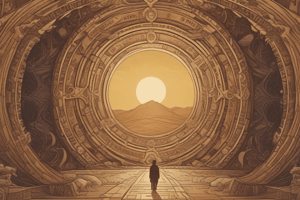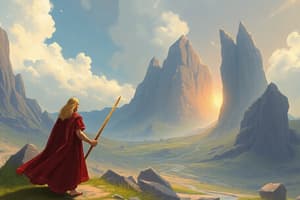Podcast
Questions and Answers
What is the main purpose of chiastic structure in storytelling?
What is the main purpose of chiastic structure in storytelling?
- Emphasize the importance of character development
- Create a linear narrative with no turning points
- Focus on developing multiple subplots within the story
- Highlight both comparisons and contrasts between the story's beginning and end (correct)
Which literary works commonly utilize chiastic structure?
Which literary works commonly utilize chiastic structure?
- Classic Greek tragedies
- Shakespearean plays
- Hebrew Bible and the New Testament's three synoptic Gospels (correct)
- Harry Potter series only
What is the primary characteristic of cause and effect structure in storytelling?
What is the primary characteristic of cause and effect structure in storytelling?
- Creating a nonlinear narrative
- Introducing random events without any consequences
- Clearly showing how one plot point leads to the next (correct)
- Focusing solely on character emotions
How does inductive structure differ from deductive structure in essay writing?
How does inductive structure differ from deductive structure in essay writing?
In deductive structure, what is the initial step taken in crafting an argument?
In deductive structure, what is the initial step taken in crafting an argument?
Which storytelling element is central to chiastic structure?
Which storytelling element is central to chiastic structure?
How does cause and effect structure contribute to the clarity of a narrative?
How does cause and effect structure contribute to the clarity of a narrative?
What distinguishes inductive reasoning from deductive reasoning?
What distinguishes inductive reasoning from deductive reasoning?
What is the primary function of chiastic structure in storytelling?
What is the primary function of chiastic structure in storytelling?
Which type of reasoning is focused on presenting evidence first to draw a broader conclusion?
Which type of reasoning is focused on presenting evidence first to draw a broader conclusion?
What makes cause and effect structure useful in chronological stories?
What makes cause and effect structure useful in chronological stories?
How does deductive reasoning differ from inductive reasoning?
How does deductive reasoning differ from inductive reasoning?
Which type of literary analysis essays are often based on deductive structure?
Which type of literary analysis essays are often based on deductive structure?
In what way does chiastic structure differ from cause and effect structure?
In what way does chiastic structure differ from cause and effect structure?
What distinguishes the chiastic structure of Harry Potter's individual books?
What distinguishes the chiastic structure of Harry Potter's individual books?
What is the key characteristic of inductive structure in essay writing?
What is the key characteristic of inductive structure in essay writing?
How does cause and effect structure contribute to the clarity of a narrative?
How does cause and effect structure contribute to the clarity of a narrative?
What distinguishes deductive reasoning from inductive reasoning?
What distinguishes deductive reasoning from inductive reasoning?
Flashcards are hidden until you start studying
Study Notes
What is Structure in Literature?
- Definition: The organization of a literary work, likened to the frame and foundation of a building.
- Purpose: To make the main point clear in an argumentative essay or paper, and to knit all elements of a story together to reinforce the thematic message.
- Importance: Tells readers what to pay attention to and what to expect, and can be an artistic and engaging part of a work on its own.
Types of Structures in Literature
- Narrative structure
- Fichtean curve
- Hero's Journey
- Chronological structure
- Three-act structure
- Compare and contrast
- Cause and effect
- Inductive and deductive
Narrative Structure
- A house-like structure with common elements: floor, roof, walls, setting, plot, characters, and theme.
- Plot contains five basic elements: exposition, rising action, climax, falling action, and denouement.
- Example: Harry Potter and the Philosopher's Stone
- Exposition: Harry's background and setting
- Rising action: Harry's journey at Hogwarts
- Climax: Confrontation with Professor Quirrell
- Falling action: Hogwarts' teachers' rescue and explanation
- Resolution: Harry's summer return and reflection
Fichtean Curve Structure
- A thriller/mystery structure with repeated crises and brief falls leading to the ultimate climax.
- Combines plot elements with exposition.
- Uses a series of mini-climaxes or crises to make up the rising action.
Hero's Journey Structure
- Based on the idea of monomyth, with common elements across stories.
- 17 steps, but not all stories contain every step.
- Hero undergoes an external quest and parallel internal journey.
- Examples: Harry Potter, Star Wars, A Wrinkle in Time.
Chronological Structure
- Follows events as they happen in a story: exposition, rising action, climax, falling action, and resolution.
- Works well for narrative essays and short stories, but less well for complex and longer works.
- Flashbacks are a literary technique used to reveal important information out of order.
Three-Act Structure
- Based on the three-act formula of plays and films.
- First act: setup, exposition, and rising action.
- Second act: confrontation, rising action, and climax setup.
- Third act: resolution, climax, and denouement.
- Example: Star Wars.
Compare and Contrast Structure
- Used most often in essays to identify similarities and differences between two or more things.
- Can be used in narrative to highlight contrasts and comparisons between characters, settings, or themes.
- Organizing methods: focusing on one item at a time, comparing first and contrasting second, or vice versa.
Studying That Suits You
Use AI to generate personalized quizzes and flashcards to suit your learning preferences.




